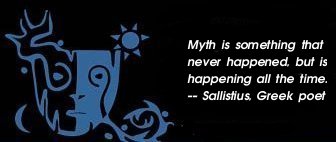|

The Twin Towers
© 2007 by Barry Spector.
 "Daddy, why do they hate us so?" "Daddy, why do they hate us so?"
Do we really need to talk about 9-11 again? I think we do, for two reasons: first, because it is clear that conventional political, economic and even theological analyses have failed to help us understand this tragedy. Second, because nearly everything we have experienced in our public and private lives — war, environmental crises, impending financial instability, governmental intrusion into individual privacy, sudden increase and then eventual decrease in confidence in our institutions, an ongoing sense of paranoia about the future, and perhaps the end of democracy itself — has developed and remained with us since those days. We need to think about 9-11 and the Twin Towers in mythological terms.
Do you remember how on the morning of the attacks TV commentators assured viewers — repeatedly — that President Bush was "in touch" with Vice-President Cheney. Things were under control, despite the carnage on the screen. An elder was guiding the young, illegitimate leader, whose poll numbers after nine months in office were abysmally low. Spokesmen unanimously declared America's goodness and the sure, quick retribution it would exact. There was no doubt. Several politicians repeated, "Make no mistake about it."
On September twelfth, a second wave of commentators offered more nuanced interpretations. Rabbi Marc Gelman, asked if the nation would be changed by this event, responded, "Yes, we have lost our innocence. We now know there is radical evil in the world."1 It was out there, and Americans, mysteriously, had never heard about it. Psychologist Robert Butterworth's son had asked him, "Daddy, why do they hate us so?"2 His response was to stare miserably at the camera. He really didn't know, and he assumed that we didn't either.
Their statements could have followed the Oklahoma City bombing, or the previous bombing of the World Trade Center, or the TWA airliner bombing, or the destroyer Cole bombing, or the assassinations of the 1960's, or any of the scenes in the past ten years where teenagers had shot up their high schools.3 America had finally — or once again — lost her innocence. Also on the 12th, Donald Rumsfeld said, "There aren't any good targets in Afghanistan and there are lots of good targets in Iraq."4
President Bush's popularity quickly soared to over ninety percent. Suddenly he appeared determined, defiant, and absolutely confident. Congress stood almost unanimously behind him, while American flags appeared everywhere. There was simply no doubt that America would get through this crisis stronger and more united than before.
On the thirteenth, Clear Channel, owner of 1,200 radio stations, banned airplay of 150 songs, including Peace Train and Imagine. The fourteenth was a national day of prayer and remembrance. President Bush sanctified a new crusade by promising to "...rid the world of evil."5 September eleventh, however, was already a day of mourning. It was the anniversary of the American-financed coup in Chile in 1973, and the murder of South African resistance hero Steven Biko by the U.S.-supported Apartheid regime in 1977.
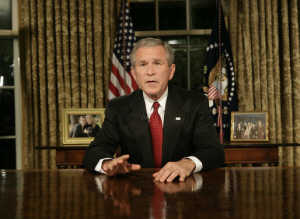 On the fifteenth President Bush decided to invade Iraq.6 A week later, Time proclaimed, "America Unites." The president announced, "Either you are with us, or you are with the terrorists."7 The young king was no longer illegitimate. Although the hyper-inflated, phallic World Trade Center structures had collapsed, America stood erect behind the President, who had symbolically absorbed the terrorist blow without flinching. By the end of the month, President Bush was arguably the most popular person in the world — and Osama Bin Laden was probably second. The two fundamentalists (entitled sons of two closely connected families) stood like the cousins Dionysus and Pentheus (in The Bacchae by Euripides) as mirror opposites of each other. On the fifteenth President Bush decided to invade Iraq.6 A week later, Time proclaimed, "America Unites." The president announced, "Either you are with us, or you are with the terrorists."7 The young king was no longer illegitimate. Although the hyper-inflated, phallic World Trade Center structures had collapsed, America stood erect behind the President, who had symbolically absorbed the terrorist blow without flinching. By the end of the month, President Bush was arguably the most popular person in the world — and Osama Bin Laden was probably second. The two fundamentalists (entitled sons of two closely connected families) stood like the cousins Dionysus and Pentheus (in The Bacchae by Euripides) as mirror opposites of each other.
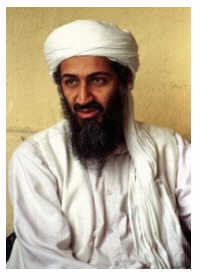 But focus on Osama Bin Laden reinforced the notion that the system still works; it is only the evil individual (the lone villain, opposed to the lone hero) who causes the occasional breakdown of trust. In the War On Terror, the terrorist mastermind, ruler of the evil hordes, joined the lone gunman as a stock character in American myth. But focus on Osama Bin Laden reinforced the notion that the system still works; it is only the evil individual (the lone villain, opposed to the lone hero) who causes the occasional breakdown of trust. In the War On Terror, the terrorist mastermind, ruler of the evil hordes, joined the lone gunman as a stock character in American myth.
A month later, President Bush verbalized the consensus of innocence betrayed: "How do I respond when I see that in some Islamic countries there is vitriolic hatred for America?...Like most Americans; I just can't believe it because I know how good we are."8
Government spokesmen exhorted Americans to return to normal, to show the world that they, like the President, were unfazed by the attacks, replacing grief with resolute action. Americans were to go back to consuming, even while people were being consumed before their very eyes; the poor had grown significantly in 2001, to thirty-three million. Nearly a million black children were living in "extreme poverty," the highest level in a generation.9
Do you remember how many changes happened by the beginning of 2002? Fully eighty-nine percent of the public supported the invasion of Afghanistan. The government enforced drastic reductions in personal freedoms, incarcerating hundreds of citizens and legal aliens.10 New phrases entered the language — Homeland Security, weapons of mass destruction, regime change, and the Patriot Act — while Attorney General Ashcroft spent $8,000 to have a nude statue of Justice veiled.
Preoccupied with the anthrax scare, few noticed that Congress had passed the entire Republican agenda.11 But a January poll revealed that confidence in the President, the military and the Federal Government had climbed to their highest levels since Watergate.12 Everywhere, large, gas-guzzling cars carried American flags. SUV sales passed sales of regular cars. People commonly spoke of how their lives had changed forever, even as consumer life-styles remained unfazed.

Others, resisting the war fever, spoke of a magnificent opportunity, a kairos moment.13 As African-American theologian Cornel West said, America had a chance to experience the suffering that other nations, women and African-Americans have always known, that America had been "niggerized."14 Noam Chomsky observed, "Welcome to the club."15 But the moment passed.
The fundamental American myths of heroism, progress, masculinity, exceptionalism, privilege, and innocent good intentions were alive on 9/11/2001. Then, as Rabbi Gelman said, we lost our innocence — or did we? I suggest that when society is constructed upon such myths, any and every assault on our assumptions seems like the first time, because the veil of innocence drops automatically after each previous event. Regardless of historical memory, we are always, by definition, unprepared. The assault against Eden is always the first assault.
Theologian and psychologist Christine Downing notes that public trauma reawakens the private, individual traumas of birth and childhood. We encounter long-repressed feelings of "how precarious and illusory our everyday sense of order and stability is." We are pulled back into old fears of annihilation, "and our even more repressed longing for death, peace, resolution and completion."16
A certain sense of innocence is indispensable for anyone to live productively. We need to forget life's tragedies, at least enough to go on with life. Furthermore, in the demythologized conditions of modern life, few of us are confident that we have the necessary ritual containers to confront the great backlog of grief that we all carry. So the sense of individual innocence keeps us from constantly re-experiencing loss.17
National innocence, however, is constructed on a very different foundation. Its purpose is to keep us from confronting America's history of perpetrating suffering upon others and, indeed, upon ourselves. Those Europeans who conquered the New World had been victimized, in a sense, merely by having been born into a world whose myths were no longer viable enough to protect them from the fires of existence. Domination of the New World allowed them to inflict their sense of victimhood directly upon its native peoples, and thus to experience the relief of a myth of innocence. The padres undoubtedly thought — as they whipped native slaves for minor infractions — "It is for their own good."
National innocence implies exceptionalism, uniqueness, and the most profound ignorance. University of Chicago professor Mark Slouka recalls teaching a seminar in early Christianity where a young woman admitted without any irony, "...I always thought Jesus was an American." To Slouka, she was speaking, "as succinctly as I have ever heard it articulated ...with almost poetic compaction...the core myth of America."18 Only such naïveté could match the arrogance and hubris of the two thousand-foot-high towers.
The repressed longing that Downing speaks of is not a simple yearning for actual death, but for the symbolic death, the initiation into a new identity, that Pentheus undergoes. From the point of view of the two-billion malnourished persons in the world, from the point of view of the Pagan gods, especially Dionysus, the Twin Towers were a statement in steel and concrete of America's innocence and its unconscious desire to be awakened. They were a monumental gesture, a dance before the hut of the elders, and an invitation to "bring it on," as President Bush taunted the terrorists from the deck of his aircraft carrier, to kill the boy-hero so that a mature man of sorrow (the literal meaning of "Pentheus") might arise. Innocence eventually evokes betrayal.
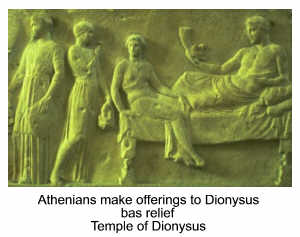 Many Americans had experienced a few weeks of shared compassion and introspection. The veils had risen and the national illusion was briefly undone. Great things were possible; Americans, like Athenians in the Theater-temple of Dionysus, suffered together for perhaps the first time.19 But quickly the president encouraged the nation to go shopping and move on. The wheels were set in motion to re-invigorate the myth of innocence by converting grief directly into the grinding desire for release through vengeance.20 After all, said government and media with one voice, the attacks were unprovoked, and thousands of innocents had died. Many Americans had experienced a few weeks of shared compassion and introspection. The veils had risen and the national illusion was briefly undone. Great things were possible; Americans, like Athenians in the Theater-temple of Dionysus, suffered together for perhaps the first time.19 But quickly the president encouraged the nation to go shopping and move on. The wheels were set in motion to re-invigorate the myth of innocence by converting grief directly into the grinding desire for release through vengeance.20 After all, said government and media with one voice, the attacks were unprovoked, and thousands of innocents had died.
In a culture that attaches such importance to the Hero — perpetually growing, standing alone, conquering all obstacles, protecting the innocent, competing successfully at athletics, in the offices, on the battlefield, and, one supposes, finally dying with the most toys — we find only one alternative. Under capitalism, one is either a hero/winner or one is a loser, a victim. And the stance of victim requires a perpetrator.
But vengeance establishes a sense of identity and continuity and allows us to feel powerful rather than victimized. We dissolve our sense of conscience and perceive our aggression as self-defense. Significantly, psychologist Lionel Corbett argues that "rage can also cover up feelings of guilt that we secretly approved of the attacks."21 If our longing for initiation has no other outlet than images of literal destruction, then we will certainly feel guilty when those images become reality, and we will certainly need to deny that guilt.
Mythic Images of the Twin Towers
 When the acceptable range of public discourse colludes to re-invigorate myth, only a mythic imagination can move the story along. Many mythologies share a common theme of cataclysm ("to wash down") or catastrophe ("to turn down") — natural disasters such as earthquakes, floods, and volcanic eruptions.22 The Judeo-Christian tradition perceives such divine punishment as the result of sexual transgressions and reversions to Paganism. The Greeks saw these events as retribution (Nemesis) for excessive arrogance and pride (Hubris), which is symbolized as towers that touch heaven in Egypt, Mexico, Assam, Burma, and native America.23 When the acceptable range of public discourse colludes to re-invigorate myth, only a mythic imagination can move the story along. Many mythologies share a common theme of cataclysm ("to wash down") or catastrophe ("to turn down") — natural disasters such as earthquakes, floods, and volcanic eruptions.22 The Judeo-Christian tradition perceives such divine punishment as the result of sexual transgressions and reversions to Paganism. The Greeks saw these events as retribution (Nemesis) for excessive arrogance and pride (Hubris), which is symbolized as towers that touch heaven in Egypt, Mexico, Assam, Burma, and native America.23
 Key XVI: The Tower appears in countless versions of the European Tarot as a medieval castle, a Babylonian ziggurat, a skyscraper, a prison, or even the White House. It may be collapsing in flames from an earthquake or lightning bolt. Sometimes human bodies fall from it, or pieces of it fall and strike the king. It represents the structures we construct to both hide and reveal our incomplete selves. The Tower, writes Shanti Fader, is a place of "fear, and jealous, possessive pride, designed to keep out love..."24 Students of The Bacchae recall Pentheus bellowing, "I shall order every gate in every tower to be bolted tight."25 Key XVI: The Tower appears in countless versions of the European Tarot as a medieval castle, a Babylonian ziggurat, a skyscraper, a prison, or even the White House. It may be collapsing in flames from an earthquake or lightning bolt. Sometimes human bodies fall from it, or pieces of it fall and strike the king. It represents the structures we construct to both hide and reveal our incomplete selves. The Tower, writes Shanti Fader, is a place of "fear, and jealous, possessive pride, designed to keep out love..."24 Students of The Bacchae recall Pentheus bellowing, "I shall order every gate in every tower to be bolted tight."25
It may represent esoteric knowledge that has swollen out of control, like the Tower of Babel: "Except the Lord build the house, they labor in vain that built it."26 Yahweh's response to the building of the tower was to punish the people by "confounding their language that they may not understand one another's speech; and scattered them abroad upon the face of all the earth."27 James Hillman suggests that this act prevents mankind from speaking with only one voice of monotheistic literalism. Unity (contrasted with community) leads to inflation and arrogance; the correction to this "vertical ascensionism" is the diversity that results when the people are scattered horizontally across the earth and learn to speak in many languages.28
But the terrorists (agents of another literalism) chose the Towers for their political as well as their psychological significance. A network anchorman admitted that the World Trade Center was the "symbol of American power, democracy and world trade."29 The terrorists might have added, "the world-wide American economic and military empire."
Temples to the gods in patriarchal societies are usually built as tall as possible, and/or upon the highest hills or mountains. This represents a heroic attempt, like that of Icharus, to get as far away as possible from the ground of The Mother and the natural world, a return to the abode of the sky gods.
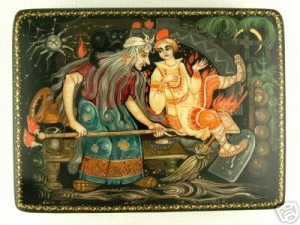 Polytheistic cultures acknowledge aspects of the divine that aren't wholly positive. Some people have suggested that the attacks were "a wake-up call from the Dark Feminine," known as Kali in India, Baba Yaga in Russia, and Coatlicue in Mexico.30 She is the one to whom all beings return, who destroys for the sake of re-creating. The Dark Mother, however, had been calling on September tenth, when 35,000 children died worldwide from malnutrition, as they have been dying every day for years. With all respect due the victims, it is characteristic American narcissism to imply that the objective amount of death and damage in New York City was greater or had more meaning than the carnage going on in the forty-odd wars being waged across the globe that same day, or in one North African famine.31 Polytheistic cultures acknowledge aspects of the divine that aren't wholly positive. Some people have suggested that the attacks were "a wake-up call from the Dark Feminine," known as Kali in India, Baba Yaga in Russia, and Coatlicue in Mexico.30 She is the one to whom all beings return, who destroys for the sake of re-creating. The Dark Mother, however, had been calling on September tenth, when 35,000 children died worldwide from malnutrition, as they have been dying every day for years. With all respect due the victims, it is characteristic American narcissism to imply that the objective amount of death and damage in New York City was greater or had more meaning than the carnage going on in the forty-odd wars being waged across the globe that same day, or in one North African famine.31
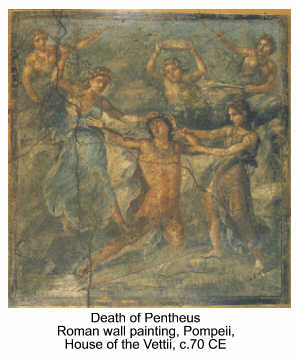 The mythic images indicate something different. In The Bacchae the collapse of Pentheus' palace occurs at precisely halfway through the play. Unlike in other tales, Dionysus doesn't kill Pentheus. In fact, he warns him several times that, "Friend, you can still save the situation!"32 Pentheus can reverse his fate — or turn fate toward a less literalized destiny — before his older female relatives kill and dismember him. He has many opportunities to "re-pent." The mythic images indicate something different. In The Bacchae the collapse of Pentheus' palace occurs at precisely halfway through the play. Unlike in other tales, Dionysus doesn't kill Pentheus. In fact, he warns him several times that, "Friend, you can still save the situation!"32 Pentheus can reverse his fate — or turn fate toward a less literalized destiny — before his older female relatives kill and dismember him. He has many opportunities to "re-pent."
From this perspective, the World Trade Center's destruction is less a wake-up call than an invitation to step out of our ignorance into the painful yet spacious experience of the lives we were meant to live. As Rumi said, "If you don't become a rebirth, you'll never know what real life is." Or as Goethe wrote, "...so long as you haven't experienced this — to die and so to grow — you are only a troubled guest on the dark earth."
The Great Mother acts with broader strokes. If she reaches the point of no return, she will engage the entire ecosystem. She will paint her picture with global warming, species extinction, pandemics, nuclear holocaust, or the collapse of agriculture.33 But she is patient; there is still time. Feder sees the destruction of the Tower as "clearing away ... outmoded ideas and patterns ... obstacle to wholeness ... which may well have served a purpose at one time.34 At the end of The Bacchae, Dionysus implies that uninitiated boy-kings, should they awaken, might "... have an ally ... in the son of Zeus."35
There is much fear just below our characteristic American cheerfulness. I don't simply mean the fear of "the Other" that elites have manipulated for centuries. Many live as if there will be no future. Others — millions — imagine Biblical apocalypse, or secular endings ranging from nuclear war and terrorist catastrophe, to Y2K and global warming.
We can hardly minimize the actual dangers we confront. Yet if we examine the fear — or, if we were honest, the anticipation — that many obviously display, we'd be closer to the psychic energy that drives us: the archetypal cry for initiation. At the root, apocalypse is a metaphor for the death and rebirth of the ego in the process of personal transformation.
We live in one of those rare moments in world history when the dominant cultural values are in a wild state of transition that actually mirrors the initiatory liminality experienced — or longed for — by adolescents everywhere. And yet, our demythologized world has stripped us of the ability to think metaphorically. When we can no longer imagine inner renewal, we project literal images onto the natural world.36 This bizarre mix of deep pessimism and religious longing has indeed created its own reality. Christian expectations of the end times have profoundly influenced our Mid-East polices, leading to George W. Bush's presidency, 9-11, and the Iraq war.
But we can find deeper meanings to "end of days" in worldwide ritual traditions. Tribal people celebrated year's end, often at the winter solstice, by extinguishing and rekindling fires, welcoming the temporary return of the dead, acknowledging the community's sins, staging mock battles between cosmos and chaos, and re-telling creation stories.37 They re-enacted primordial chaos and liminality in order to revive a world in decline. In the turning of the larger cycles, storytellers told of deteriorating values, periods of darkness, floods, and conflagrations — even humanity's disappearance — before the return of the sun and the birth of the new world. This much older, indigenous expectation of cyclic renewal predates by millennia Christian anticipation of the end.
There is yet another meaning to "endings." Seen from the mystic perspective, from the inspired eye of the poet, or from the cyclic movements of our lungs, each moment expresses both aspects of life — birth and death. Both the literal mind of the fundamentalist, and the apostles of technological progress, however, have lost this pagan form of attention.
Again, this is not to deny the huge and painful transition we are undergoing. What are our possible responses to the facts of great endings, which we experience emotionally as death and ideologically as apocalypse? The proper response is to fully engage in the universal experience of extended mourning. We must learn — while we still can — from indigenous people who still know how to grieve.
"Apocalypse" literally means to lift the veil. At the end of an age, we are granted the opportunity to see the truth that has been veiled behind outdated myths. In mourning and letting go of what is dying, we can discover new (or much older) truths. Remembering the Celtic proverb — "Death is the middle of a long life" — we can see more clearly for a while, and gain the strength to support what is struggling to be born.
- CNN, 9/12/01
- Ibid
- Rodriguez, Luis, Hearts And Hands: Creating Community In Violent Times (NY: Seven Stories Press, 2001), p. 11-12. In the context of this essay it is important to note that 31 of the 33 high school shooters were white.
- Rumsfeld quoted in Clarke, Richard, Against All Enemies (Free Press, 2004)
- Remarks at September 14th Prayer Service
- Paul Wolfowitz interview in Vanity Fair, 5/9/03
- Jewett, Robert, and Lawrence, John S., Captain America and the Crusade Against Evil (Grand Rapids: Eerdmans Publishing, 2003), p. 16
- Boston Globe, 10/12/2001, p. 28
- Extreme poverty is defined by the Children's Defense Fund as disposable income of $7,064 for a family of three.
- Over 5,000 suspects were arrested without achieving a single lasting conviction.
- Between Oct. 4 and Dec. 4, 2001, 389 stories appeared in the New York Times with "anthrax" in the headline, and 238 such stories appeared in the Washington Post. The anthrax was mailed to Democratic Senators Tom Daschle and Patrick Leahy, leaders of the opposition to the Patriot Act, on October 9. Chairman of the Judiciary Committee, Leahy managed the debate on the Bill. After receiving the anthrax letter, Senate Majority Leader Daschle switched from supporting a 2-year limit on the Bill, later defending a 4-year sunset clause as the "appropriate balance." No Republican received an anthrax letter. The House and Senate buildings were closed and not reopened until after the Patriot Act was passed. It became law on October 26.
- Harris Poll # 6, 1/30/2002
- The Greek word Kairos comes from the art of weaving, referring to that brief instant when the weaver may move the shuttle through the warp threads that rise and fall. It is a tiny opening in the weaving of the cloth, and of fate.
- West, Cornell, Democracy Matters (Penguin, 2004), p. 20
- Chomsky, Noam "Reasons to Fear U.S.," Toronto Star, 9/12/03
- Lecture, Pacifica Graduate Institute, April, 2002
- --By contrast, therapeutic containers are designed to allow such experiences.
- --Slouka, Mark, "A Year Later," Harper's Magazine, September, 2002
- --The only other images we have of such shared suffering are the funerals of Lincoln and John Kennedy.
- -- A 2006 survey revealed that 85% of U.S. soldiers in Iraq still believed that their mission was mainly "to retaliate for Saddam's role in the 9-11 attacks" ().
- Downing, Christine, lecture, Pacifica Graduate Institute, April, 2002
- Flood myths
- The Pueblo myth of Montezuma's tower to the heavens
- Feder, Shanti, "The Tower", in PARABOLA, Spring, 2002, p. 58-60
- Euripides, The Bacchae, in Euripides V, Greene & Lattimore (eds.), Arrowsmith, William (trans.) (Univ. of Chicago Press, 1968), lines 653-4
- King James Bible, Psalm 127:1
- King James Bible, Genesis:11
- Hillman, James, "Ground Zero: A Reading," in Zoja, Luigi and Donald Williams, Jungian Reflections On September 11 — A Global Nightmare (Daimon Verlag, 2002), p. 181-193
- CNN, 9/11/01
- Pat Robertson had already called the attacks a "wake-up call from God" (Los Angeles Times, 10/02/02, A6).
- Besides, invoking the Dark Mother sounds a bit like blaming the women once again.
- Bacchae, line 802
- As Demeter acts when her daughter Persephone is carried off by Hades.
- Feder, "The Tower"
- Bacchae, line 1343
- Mervyn F. Bendle, in "The Apocalyptic Imagination and Popular Culture," surveys dozens of apocalypse-themed films of the last fifty years and notices a significant transition. Films of the late fifties such as On
the Beach evoked great pathos and depicted everyday life as "invaluable in its innocence and simplicity, something whose loss in a nuclear war would be irrevocably tragic." But by 2000, many of these films were explicitly driven by Biblical prophecies: Left Behind (2000), Left Behind II: Tribulation Force (2002), The Omega Code (1999) and Megiddo: The Omega Code II (2001). They were often characterized by a literal condemnation of humanity, shifting "from a Promethean faith in human self-determination to an Augustinian conviction of human sinfulness and weakness." (Journal of Religion and Popular Culture, Volume XI: Fall 2005
- Eliade, Mircea, Cosmos and History: The Myth of the Eternal Return (NY: Harper & Row, 1954), p. 51-75
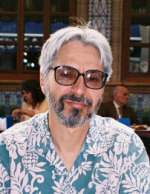 Barry Spector writes about American history and politics from the perspective of mythology and archetypal psychology. He is seeking a publisher for his book, Madness At The Gates Of The City: The Myth Of American Innocence. Barry is a regular performer at Great Night of Soul poetry events in the San Francisco Bay Area. He and his wife Maya present Oral Traditions Salons and facilitate an annual "Day of the Dead" grief ritual. Bay Area readers are encouraged to email him at shmoover@comcast.net to get on his mailing list for these events. Barry runs a furniture moving company, but he would rather move your soul.
Barry Spector writes about American history and politics from the perspective of mythology and archetypal psychology. He is seeking a publisher for his book, Madness At The Gates Of The City: The Myth Of American Innocence. Barry is a regular performer at Great Night of Soul poetry events in the San Francisco Bay Area. He and his wife Maya present Oral Traditions Salons and facilitate an annual "Day of the Dead" grief ritual. Bay Area readers are encouraged to email him at shmoover@comcast.net to get on his mailing list for these events. Barry runs a furniture moving company, but he would rather move your soul.
Return to Mythic Passages Menu
Subscribe to the Mythic Passages e-magazine
|
